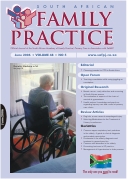A Study of health workers' knowledge and practises regarding leprosy care and control at primary care clinics in Eerstehoek area of Gert Sibande district in Mpumalanga Province, South Africa
Abstract
Background Leprosy is now a rare disease in South Africa. It does still occur, however, and it is an important cause of preventable disability. The target of eliminating leprosy as a public health problem has long been reached in the country in terms of the World Health Organization (WHO) definition of less than one case of leprosy per 10 000 population. However, there is still a commitment to the eradication of the disease in the country.1 Also, as leprosy is a chronic communicable disease with an extraordinary long incubation period, it is expected that even in areas where the elimination target has been reached, a proportion of the population infected several years ago will show clinical disease, resulting in the occurrence of new cases for many years to come. There is, therefore, a continuing need for vigilance regarding leprosy in South Africa. The low prevalence of leprosy in South Africa is found mostly in the eastern coastal areas and the south-eastern Highveld region, comprising mostly the provinces of Eastern Cape, KwaZulu-Natal and Mpumalanga. The strategy of leprosy care and control programmes in the country is currently that of decentralisation and integration into the general health care services at the primary health care (PHC) level in accordance with the WHO recommendations. The low prevalence of leprosy is associated with a fear of the loss of leprosy-specific skills within the healthcare services that could result in considerable delay in the diagnosis and treatment of the disease. One of the goals of the South African leprosy care and control programme is the maintenance of a high level of awareness of leprosy by health workers (HWs) at the primary care level of the general healthcare services in order to ensure early diagnosis and treatment of the disease in the light of the low prevalence. A successful leprosy care and control programme within the general healthcare services at the PHC level is highly dependent upon the HWs having adequate knowledge of, and practical training on, leprosy. Methods This study describes PHC workers’ knowledge of leprosy, and their practical involvement in leprosy care and control activities at PHC clinics in the Eerstehoek area of Gert Sibande district in Mpumalanga Province, South Africa, where leprosy still occurs. Results The results of the study reveal that the PHC workers have a general lack of basic clinical knowledge of leprosy, and a very low level of practical involvement in leprosy work at the PHC clinics in the area. A majority of the PHC workers expressed the desire for training on leprosy, and the willingness to provide care to leprosy patients at the PHC clinics. Conclusion Training strategies that are recommended to improve the PHC workers’ knowledge of leprosy and to promote their practical involvement in leprosy work at the PHC clinics include: more emphasis on leprosy teaching during the training of PHC workers at training institutions, more leprosy-specific in-service training of the PHC workers, special training of the PHC workers on practical leprosy work, and regular follow-up and supervision of the PHC workers at PHC clinics by specialised or experienced leprosy workers. SA Fam Pract 2006;48(5): 16)
Issue
Section
Original Research
By submitting manuscripts to SAFP, authors of original articles are assigning copyright to the South African Academy of Family Physicians. Copyright of review articles are assigned to the Publisher, Medpharm Publications (Pty) Ltd, unless otherwise specified. Authors may use their own work after publication without written permission, provided they acknowledge the original source. Individuals and academic institutions may freely copy and distribute articles published in SAFP for educational and research purposes without obtaining permission.

